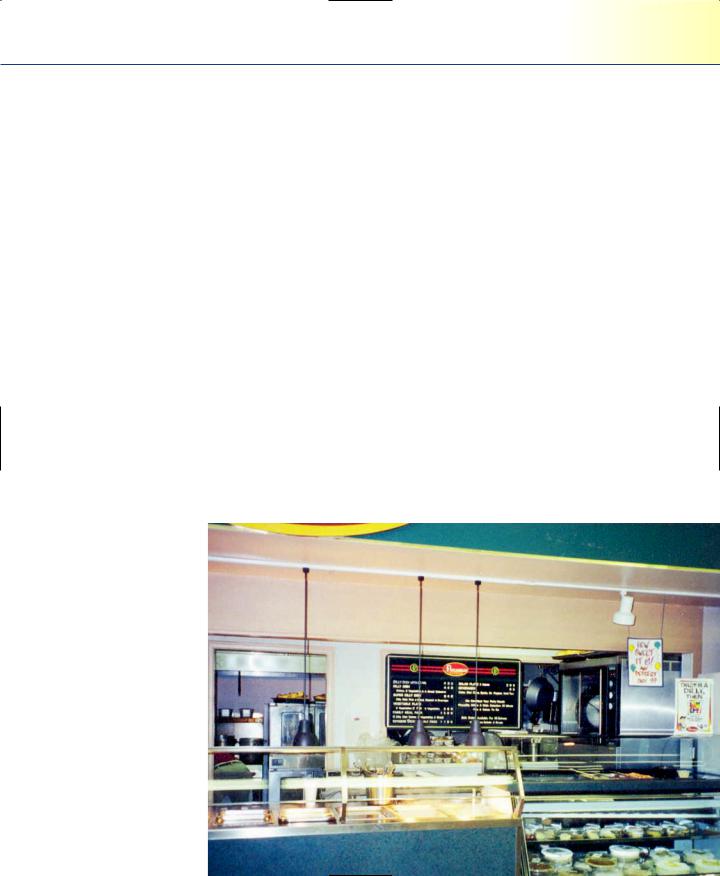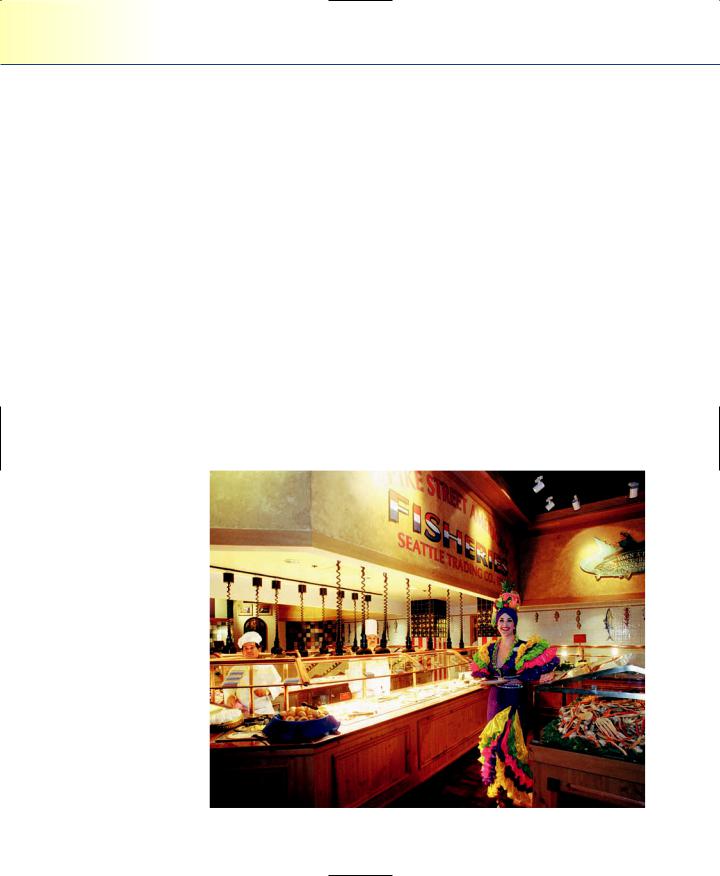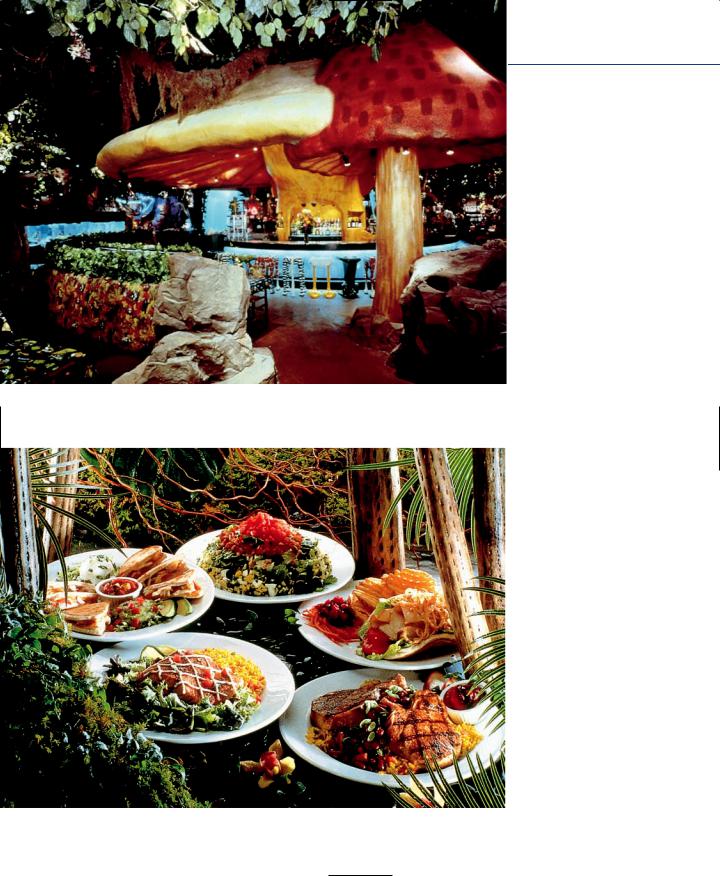
- •CONTENTS
- •PREFACE
- •Content—Benefits for Students
- •Content—Benefits for Instructors
- •Features of the Book for Students and Instructors
- •Supplementary Materials
- •Acknowledgments
- •What Is Hospitality Management?
- •The Manager’s Role in the Hospitality Industry
- •Why Study in a Hospitality Management Program?
- •Planning a Career
- •Employment as an Important Part of Your Education
- •Getting a Job
- •Employment at Graduation
- •The Outlook for Hospitality
- •Summary
- •Managing Change
- •Demand
- •Supply
- •Workforce Diversity
- •The Impact of Labor Scarcity
- •Summary
- •The Varied Field of Food Service
- •The Restaurant Business
- •The Dining Market and the Eating Market
- •Contemporary Popular-Priced Restaurants
- •Restaurants as Part of a Larger Business
- •Summary
- •Restaurant Operations
- •Making a Profit in Food Service Operations
- •Life in the Restaurant Business
- •Summary
- •Chain Restaurant Systems
- •Independent Restaurants
- •Franchised Restaurants
- •Summary
- •Competitive Conditions in Food Service
- •The Marketing Mix
- •Competition with Other Industries
- •Summary
- •Self-Operated Facilities
- •Managed-Services Companies
- •Business and Industry Food Service
- •College and University Food Service
- •Health Care Food Service
- •School and Community Food Service
- •Other Segments
- •Vending
- •Summary
- •Consumer Concerns
- •Food Service and the Environment
- •Technology
- •Summary
- •The Evolution of Lodging
- •Classifications of Hotel Properties
- •Types of Travelers
- •Anticipating Guest Needs in Providing Hospitality Service
- •Service, Service, Service
- •Summary
- •Major Functional Departments
- •The Rooms Side of the House
- •Hotel Food and Beverage Operations
- •Staff and Support Departments
- •Income and Expense Patterns and Control
- •Entry Ports and Careers
- •Summary
- •The Economics of the Hotel Business
- •Dimensions of the Hotel Investment Decision
- •Summary
- •The Conditions of Competition
- •The Marketing Mix in Lodging
- •Product in a Segmented Market
- •Price and Pricing Tactics
- •Place—and Places
- •Promotion: Marketing Communication
- •Summary
- •The Importance of Tourism
- •Travel Trends
- •The Economic Significance of Tourism
- •The United States as an International Tourist Attraction
- •Businesses Serving the Traveler
- •Noneconomic Effects of Tourism
- •Summary
- •Motives and Destinations
- •Mass-Market Tourism
- •Planned Play Environments
- •Casinos and Gaming
- •Urban Entertainment Centers
- •Temporary Attractions: Fairs and Festivals
- •Natural Environments
- •On a Lighter Note. . .
- •Summary
- •Management and Supervision
- •The Economizing Society
- •The Managerial Revolution
- •Management: A Dynamic Force in a Changing Industry
- •What Is Management?
- •Summary
- •Why Study Planning?
- •Planning in Organizations
- •Goal Setting
- •Planning in Operations
- •The Individual Worker as Planner
- •Long-Range Planning Tools
- •Summary
- •Authority: The Cement of Organizations
- •Departmentalization
- •Line and Staff
- •Issues in Organizing
- •Summary
- •Issues in Human-Resources Management
- •Fitting People to Jobs
- •Recruiting
- •Selection and Employment
- •Training
- •Retaining Employees
- •Staff Planning
- •Summary
- •The Importance of Control
- •Control and the “Cybernetic Loop”
- •Tools for Control
- •Summary
- •Leadership as Viewed by Social Scientists
- •Why People Follow
- •Leadership Theories
- •Communication
- •The Elements of Leading and Directing
- •Developing Your Own Leadership Style
- •Summary
- •A Study of Service
- •Rendering Personal Service
- •Managing the Service Transaction
- •How Companies Organize for Service
- •Summary
- •INDEX

76Chapter 3 The Restaurant Business
side door again?” The single-number system is spreading and is being used not only for pizza but also for a wide variety of other food service delivery products.
Contemporary Popular-Priced Restaurants
We have already discussed casual upscale restaurants and off-premise dining. In this section, we will discuss the on-premise business of the two largest segments of today’s popular-priced restaurant business: QSR and midscale operations (such as
family restaurants and commercial cafeterias).
To compare two of the more traditional restaurant formats (full-service and quickservice operations), quick-service restaurants account for slightly less than half of all restaurant sales (compared to 28 percent in 1970) and nearly three-quarters of customer traffic. Full-service restaurants, including both midscale and upscale, with a much lower share of traffic still achieve just over one-half of restaurant dollar sales because of their higher check average.
The QSR segment has experienced healthy growth, but the results for full-service operations have shown wide variation—generally lagging behind the QSR segment in the early 1990s and exceeding their growth in the latter part of the decade. The two segments cannot escape comparison, since one’s loss is often the other’s gain and vice versa.
In Figure 3.1, the various types of restaurants are compared in terms of their price level and the meal experience that is provided. The meal experience includes the services and amenities provided, as well as such factors as the time available, the importance of convenience (as in location), the degree to which the meal is utilitarian (i.e., a biological event), and the degree to which it is tied to other activities. Utilitarian meals (a hurried lunch during the working day) where convenience and speed are essential would be at one end of the dining experience scale. A special occasion, perhaps a wedding anniversary celebration, where a couple might drive 50 miles to visit a unique restaurant and spend two or three hours dining, would be at the other end.
The full-service segment includes an important subsegment: midscale restaurants. These operations have somewhat higher prices (about $7.00 to $10.00, compared to $5.00 to $7.00 for QSRs).
With this overview in mind, let us now turn our attention to a more detailed consideration of the basic restaurant groups identified.
QUICK-SERVICE RESTAURANTS
One managerial concern that helps to distinguish between the various segments is their individual levels of productivity. Table 3.2 reflects productivity levels across several food service segments. An understanding of productivity is important from a management

Contemporary Popular-Priced Restaurants |
77 |
|
High |
Fine dining |
|
|
|
|
|
|
|
Casual upscale |
|
|
|
dining |
|
|
|
HMR |
|
$ |
|
|
|
Price |
Midpriced |
Midscale |
|
restaurants |
|
||
|
|
||
|
|
QSR |
QSR |
|
|
(off |
|
|
|
(on |
premises) |
|
|
premises) |
|
|
Low |
|
|
Service focusing on dining and meeting primarily social needs
Service focusing on eating, primarily meeting biological needs
Restaurant meal experience
Figure 3.1
Factors bearing on meal experience include time available, importance of convenience, utilitarian as opposed to social event, and degree of subordination to other activities.
perspective. For instance, note that QSR operations lead the way in productivity—such operations tend to simplify their production processes and use self-service. The result is a drastic reduction in labor in both the front and back of the house. Because QSRs require less labor, they can pass on their savings to the customer in the form of lower prices. Furthermore, these operations, even with their lower prices, have historically earned profits substantially higher than those of other operations.
The Quick-Service
Concept. Some people do not realize how long quick-service (formerly fast food) has been with us—quick- service restaurants are the product of a long evolution dating back to the 1940s (for instance,


 TABLE
TABLE 3.2
3.2






















































Productivity in Food Service Establishments
FOOD SERVICE TYPE |
DIRECT LABOR HOURS PER 100 GUESTS |
Quick-Service |
10.5 |
Cafeterias |
18.3 |
Family restaurants |
20.7 |
Luxury restaurants |
72.3 |

78Chapter 3 The Restaurant Business
Carl Karcher began with a hot dog cart in 1941 and In-N-Out, a California institution, began in 1948). Other companies also got their start around this same time. Despite the array of quick-service choices, any discussion of fast food must begin and end with McDonald’s. McDonald’s began as a drive-in, selling inexpensive hamburgers, french fries, and milk shakes to be consumed in the car or taken away. The original menu was very limited. It is still very fresh in one author’s mind the day that McDonald’s decided to expand its menu to include apple pie. The company has obviously made other, and more significant, changes in the last 25 years.
From a small production unit, McDonald’s expanded the food pickup area in the front of the store slightly to provide a limited amount of seating. This worked well enough that a larger seating area was added to one side—and then to both sides—of the production unit. These units were still originally quite simple, with plain white walls for ease in housekeeping. The early units had a utilitarian air about them. Gradually, however, decoration was added to the seating area, very simply at first and then more extensively. Today, McDonald’s restaurants are generally attractively decorated, and some units are quite elaborate. In 2002, McDonald’s announced that it would reinvest a significant amount of capital into its older restaurants, focusing on physical improvements and, in some cases, total remodeling. McDonald’s is but one example of some well-established quick-service companies that are undergoing remodeling/renovation plans to their restaurants. Other companies following a similar strategy include Burger King, Sonic, and Taco Bell.
The decor and physical plant were certainly not the only things that evolved. The early, very simple menu was gradually expanded. To attract people who wanted something other than a variety of hamburgers, chicken and fish were added. To attract an increasingly health-conscious public, salad and decaffeinated coffee were added. To meet demand for service earlier in the day, breakfast was added. Although the menu still remains quite simple, the hamburger-only menu of the early days has been replaced by much wider variety.
McDonald’s has periodically faced difficult internal and external challenges, including crowded markets, well-heeled competitors set on taking away its customers, and disgruntled franchisees. For a short time, their stock prices suffered as a result of these challenges, there was a change of CEOs, and the company closed some restaurant locations. They have since refocused, upgraded some restaurants, and slowed their growth rates. They began to turn things around in 2003 and 2004, which was evidenced by an increase in same-store sales, a measure of performance. Now with over $50 billion in annual worldwide sales, McDonald’s is the best-selling food service brand in the world, with over three times the sales of the next largest brand.10 We can, therefore, safely proclaim the original concept and subsequent evolution of McDonald’s to be a resounding success.
This evolution of the QSR concept at McDonald’s was matched in a general way by other quick-service giants. Over time, quick-service menus came to offer a wider selection, until they were offering enough choice to make them a serious threat to family restaurants because of their lower prices.

Contemporary Popular-Priced Restaurants |
79 |
The key to the success of quick service, nevertheless, is its simplicity. A key simplification remains quick service’s limited menu. Each item on the menu has been engineered to simplify and standardize its purchasing, production, and service. Simplification of the production process permits the use of unskilled labor. The quick-service operation is, in many ways, more like a manufacturing enterprise than a traditional restaurant. Even a cursory tour of the back of the house of any quick-service restaurant will support this statement.
Unique Characteristics. The presence of quick-service operations in every market of any size is a key characteristic of quick service and one of the main factors supporting its growth over the past 50 years. Because of their many locations, they make eating out convenient. That convenience reinforces patronage. Further, quickservice food seems to cut effectively across a variety of demographic groups. It has truly become an integral part of living in North America and, increasingly, in other parts of the world.
We have already noted that simplified menus and operations that use unskilled labor result in a price that is very attractive to the consumer. This simple operating format results in fast service and has earned quick service its name. Self-service is built into the operating format, reinforcing both speed of service and lower cost, especially in the absence of any tipping.
The quick-service segment is dominated by chains, which introduces an interesting note of complexity into what appears to be a fairly simple operation. Although the operation of any single QSR unit is relatively straightforward compared with other, more service-intensive restaurants, the operation of the restaurant chain as a whole—that is, as a system of interactive parts—is highly complex. With over 30,000 systemwide restaurants (over one-half are outside of the United States), McDonald’s requires a huge management structure to make all the parts of the system function together in a consistent fashion that the consumer can depend on.
An interesting illustration of this complexity can be found in the area of purchasing. When the corner restaurant adds baked potatoes or chicken to the menu, the whole process can be accomplished by instructing the cook, ordering the necessary ingredients, and changing the day’s menu. In a complex system, however, much more is involved. When Wendy’s first added baked potatoes to its menu, for instance, the entire U.S. potato market was disrupted by the huge increase in demand. Similarly, when Burger King introduced the bacon cheeseburger, those three strips of bacon (multiplied by millions of customers) so increased the demand for bacon that it disrupted the national commodities market in hog bellies.
Although we have asserted that a fast-food unit is a relatively simple operation, it is not true that managing one is in any way a simple task. Managing the very tight quality and cost controls on which QSR operations depend is, indeed, demanding. Very

80Chapter 3 The Restaurant Business
high sales volumes and extreme peaks and valleys of demand throughout the day require managers to hire numerous part-time employees whose schedules vary from day to day and week to week. Keeping this crew properly trained and motivated is a major task, particularly in this age of low unemployment. Given the costs associated with turnover, such as lost training time as well as the management time required to hire and train new employees, maintaining staff morale is also a major factor in controlling payroll costs. That means real leadership skills are needed.
Quick service, as you will have noticed, is dominated by chain organizations (many of which are franchises). This is probably true because there are real economies of scale available to operations that are—within a given chain—virtually clones of one another. These economies are achieved not only in purchasing raw product but also in advertising and marketing and in the development of operating skills. A person new to the business must necessarily follow a learning curve in which he or she begins with ignorance of food service and only gradually develops sufficient know-how to operate successfully. The concept of the learning curve is simply that over time, with acquisition of knowledge and experience, a person develops greater abilities. A management trainee or franchisee of a successful chain can use the systems developed by the organization to begin well ahead on the management learning curve and to move more quickly along that curve.
Another reason for chain dominance is the highly standardized product. How much difference is there, really, between one hamburger and another, or between fried chicken products? With such a simple and narrow product line, it is difficult for an independent in this segment to achieve a viable basis for product differentiation. What-


 TABLE
TABLE 3.3
3.3






















































What Makes Quick-Service Food Different?
Location strategy (they are everywhere)
Relatively limited menus
Sales volume (very high and highly variable)
Fast service (high degree of self-service)
Numerous part-time employees with various schedules
Use of unskilled labor and highly skilled management
Key role for unit managers
Highly competitive prices
Chain domination
Simple unit, complex system
ever differentiation the independent may achieve, it must then withstand the blast of advertising deployed by its chain competitors. For all these difficulties, smaller regional chains, however, can and do compete successfully against the market leaders—in their own regional markets.
As we have suggested, quick service is a vital North American social institution and one that has been adopted by many countries around the globe. In Table 3.3, we summarize its most significant distinguishing characteristics.

Contemporary Popular-Priced Restaurants |
81 |
Quick Service’s Continuing Evolution. We noted at the beginning of this section that the quick-service industry of today is the product of over 50 years of evolution, and this process continues. Profit-oriented companies sometimes make mistakes, but they quickly correct them if they want to survive.
One of the positive aspects of quick service’s evolution was the upgraded unit’s physical plant and decor. Because of the high capital costs (such as depreciation and interest on borrowed capital), however, the cost of building a unit has a major impact on its cost structure. As investment costs began to mount in the 1980s, they drove costs out of line. New, smaller prototype units, however, have now been developed that reduce this investment.
New product development has also been a vital force in rejuvenating quick-service concepts. Whenever a Wendy’s concept has become dated in consumers’ minds—and sales have begun to fall—the company has redefined its business with new products. Beginning with salad bars and baked potatoes, food bars, the Fresh Stuffed Pita, and, more recently, the Garden Sensations, the company has regained its earlier popularity— and done so repeatedly.
The quick service business is concentrated in the breakfast and lunch day parts and, to a lesser degree, in snack periods. All of these day parts have in common a relatively smaller check average than dinner, and most firms are continually seeking to enter the higher-check-average dinner day part.
Distribution: Expanding Points of Distribution. Distribution refers to the marketing problem of gaining a presence in many markets. Quick-service chains and other food service operators began several years ago to expand the number of markets they could serve by developing not just downsized units but special limited versions of their concepts. These newer prototypes were developed to be able to offer some of the company’s product line in locations such as colleges and universities, shopping malls, retail outlets, hospitals, and the like. These smaller points of distribution (or PODs) can be located almost anyplace where there is consumer traffic. The large unit in which a POD is located is called a host. Hosts provide venues for PODs. Venues are analogous to a restaurant location, but they denote not only a place but also a particular category of guests that the host’s premises provide: students at colleges, shoppers in a department store, workers in an office complex. Hosts and food service operators benefit each other. Food service enhances the host’s operation by providing additional service to its customers, another revenue stream in the form of rent, and, ideally, keeping employees, shoppers, or visitors on site longer than they might have been otherwise. The host’s venue provides a profitable location to the food service company. The theory behind PODs has been dubbed “intercept marketing,” in that the idea is to offer product wherever the consumer is,

82Chapter 3 The Restaurant Business
intercepting them in work or play. The other side of a firm’s successful distribution is consumer convenience.11 Points of distribution are proving to be a major vehicle for the continuing growth of fast food and will be discussed further in Chapter 6.
The Future of Quick Service. Perhaps the most difficult challenge that QSRs collectively face is the shift in the composition of the population, that is, the aging of the baby boomers. (Individually, the greatest challenge is more likely the ever-in- creasing competition.) Baby boomers played a major role in creating demand for fast food when they were children and for its gradual upscaling as they entered their teens and 20s in the years just before and after 1970. As they leave their youth behind and enter middle age (and beyond), baby boomers’ tastes are naturally changing. They are able to afford a more expensive restaurant and prefer a more upscale environment and more extensive service. This translates into increased demand for full-service restaurants and “newer” segments such as the fast-casual segment. The fast-casual segment is a natural extension of the traditional quick-service segment. It has been described as offering “full service quality food in a quick-service format.”12 Hudson Riehle of the National Restaurant Association states that it is “ . . . a hybrid concept that offers the convenience of a typical quick-service establishment while combining food offerings and ingredients historically associated with more ‘casual’ table service operations.”13
Examples would include Panera Bread (Missouri), Baja Fresh (California), Wingstop (Texas), Au Bon Pain (Massachusetts), and Qdoba Mexican Grill (Colorado). Some of the more “mainstream” quick-service companies are also investing in this new segment, including McDonald’s (with 3’n1) and Wendy’s (with Café Express). According to Restaurant Research, this “new” segment accounts for $3.6 billion.14
Although quick service operators have made every effort to adapt to changing tastes, the traditional QSR footprint may no longer fit their needs as well as it did when they were younger. For this reason alone, newer niche segments such as fast casual seem to be an appropriate response.
On the other hand, there is a large group of younger customers who have come along—and will continue to do so—to replace the boomers. Moreover, quick service, as we noted earlier, is a part of the harried American lifestyle. Whatever age they may be, when speed or cost is especially important, fast food is the easiest choice. As a result, quick-service management opportunities continue to be promising.
CAREERS IN HOSPITALITYQ
Indeed, with so many units in operation and with healthy growth, there is a need for large numbers of new managers to replace those who are promoted or leave the business. There is, moreover, a persistent shortage of qualified managers. Quickservice restaurants are likely to continue to offer attractive opportunities. They give significant responsibility to new managers and generous compensation to those who can deliver results. Their many units mean numerous opportunities for advancement.

Contemporary Popular-Priced Restaurants |
83 |
MIDSCALE RESTAURANTS
Although midscale restaurants may not look like quick-service operations, the heart of all their operating systems closely resembles the QSR format. Their production systems have been simplified through the development of specialized menus that serve to reduce the skill level required of employees. This, in turn, holds down wage costs and increases speed of service. Midscale restaurants might, therefore, be called “moderately fast food.” Although the customers in these operations are prepared to wait a bit longer for their food, they will not have to wait that much longer than in a QSR. We will discuss three of the more common restaurant types within this category: family restaurants, cafeterias and buffets, and pizza operations. Home meal replacement will also be discussed further in this section.
Family Restaurants: A Step Up. Family restaurants, such as Denny’s, Shoney’s, or Cracker Barrel, are table service restaurants that compete principally with QSR operations and have more in common with these lower-priced operations than with units that are more upscale. Although they provide table service, they typically offer self-service in the form of salad bars, breakfast bars, and dessert bars. Another distinguishing feature is that family restaurants usually offer breakfast, lunch, and dinner.
Family restaurants such as Piccadilly offer a different alterative to fast food. (Courtesy of Piccadilly Cafeterias, Inc.)

84 |
Chapter 3 The Restaurant Business |
Menus at family restaurants offer a wider selection, and in this they resemble their upscale cousins more than QSRs. This resemblance to full service is, however, deceiving. First, the production staff is limited to one or more short-order cooks. Almost everything is prepared to order, sometimes from scratch (as with the sandwiches and breakfast items that give the menu much of its variety) and sometimes from frozen or chilled prepared foods that are reheated to order. The production process is really almost as straightforward as the quick-service process.
Furthermore, the service the customers receive is anything but elaborate. Place settings usually consist of paper place mats and a minimum of china and flatware. Most meals consist of a choice of soup or salad, an entrée with rolls and butter, and perhaps a dessert. This reduction in courses simplifies service. Platters, sandwiches, and salads are the mainstay of the menu, all attractively but simply served. Breakfast is the largest meal for some operators and a significant one for most others. Snacks and coffee breaks are also an important source of business, particularly for family restaurants that combine a bakery with their unit. Table 3.4 shows the ten leading family chains. In this segment, chains dominate, with over three-quarters of the market.
The relatively straightforward operating format of family restaurants helps keep the cost of training new service employees manageable. In addition, the flexible menu permits operations to drop menu items when their food costs advance too rapidly, substituting less costly items.
The guests who visit a family restaurant want to be waited on, and in choosing a family restaurant, they are opting for an informal, simple, relatively inexpensive style of service. These operations generally offer a pleasant, modern restaurant located near high pedestrian or vehicular traffic and convenient to shoppers and suburban family diners.
TABLE 3.4 |
|
Ten Largest Family Restaurant Chains |
|
Denny’s |
www.dennys.com |
IHOP (International House of Pancakes) |
www.ihop.com |
Cracker Barrel |
www.crackerbarrelocs.com |
Bob Evans Farms |
www.bobevans.com |
Perkins Family Restaurants |
www.perkinsrestaurants.com |
Waffle House |
www.wafflehouse.com |
Friendly’s Restaurants |
www.friendlys.com |
Steak ‘n Shake |
www.steaknshake.com |
Marie Callender’s |
www.mcpies.com |
Village Inn |
www.villageinnrestaurants.com |

Contemporary Popular-Priced Restaurants |
85 |
Family restaurants, with their more varied menus, table service, and modest price level, offer considerable appeal to the aging baby boomer. For families, children’s menus are available that often cost less than feeding the same child at a QSR. In addition, many chains offer kids’ programs that may include a free meal on a particular night of the week. Another strong market for family restaurants is 55-to-64-year-olds, a segment of the population that has been in a growth phase since 1995. Many family restaurants offer budget menus or special selections for seniors. To appeal to all these market segments, family restaurants are offering expanded menus featuring selections that are lighter and healthier.
On the downside, the food service “pie” is only so big. That is to say, customers are willing to spend only a certain amount of their disposable income on food outside of the home. Family restaurants have been losing market share to their competitors: primarily casual restaurants and QSR operations. On one hand, customers can choose a QSR that offers less menu choice and service but lower prices and an ambience that is frequently equal to that offered by a family restaurant. At the other extreme, family restaurants face competition from casual, full-service restaurants, some of which offer prices that are not much higher. Like any operation in the middle, family restaurants have to watch out for price competition from those below and value competition from those on the next rung up. In the past, customers have shown substantially greater satisfaction with the value received in moderately priced restaurants than with QSRs or higher-priced restaurants. This suggests that customers recognize the quality of the midpriced operations, but perhaps their real preference is for something more upscale— or else they are pressed financially and must choose the lower-cost alternative. They recognize value in the midpriced segment, but the greater growth goes to that segment’s upand downscale competitors. Whatever is going on in the guests’ minds, family restaurants seem to be caught in a competitive middle ground.
Commercial Cafeterias and Buffets. These segments are primarily limited to certain regions of the United States, but between them, they represent a sizable portion of the restaurant industry. There are some slight but rather important differences between cafeterias and buffet restaurants and the category of family-oriented restaurants that we just discussed. Cafeterias are popular in the southern United States, while buffet-style restaurants seem to be most popular in the American Midwest, Northeast, and Mid-Atlantic regions. Both styles of restaurants cater to consumer markets similar to those for restaurants in the family category—that is, young families and seniors.
Cafeterias became known for serving value-laden home-style meals throughout the southern states. Customers are able to choose from a wide variety of food as they proceed down the cafeteria line. Piccadilly Cafeterias, for instance, offers customers over 130 items daily, with different core items offered each day. Other large cafeteria

86Chapter 3 The Restaurant Business
companies include Luby’s and Furr’s. Most of the activity that has occurred in this segment of late has been the result of mergers and acquisitions as opposed to expansion.
Cafeterias offer value, selection, a comfortable atmosphere, and a family environment—characteristics that appeal to several different demographic groups. The segment faces many of the same challenges that we discussed with respect to family restaurants, however.
A segment that is closer to cafeterias than it is to family restaurants is buffet-style restaurants. Buffet restaurants are similar to commercial cafeterias operationally but differ from the customers’ perspective. Their main differentiating quality is the scatter buffet concept, where restaurant guests go to different “stations” in the dining room to retrieve their food. Each station offers different types of foods. The scatter system, among other things, eliminates some of the bottlenecks that can occur as a result of customer lineups along traditional cafeteria lines. Some of the larger buffet companies include Golden Corral, Ryan’s Grill, and Shoney’s. One of the largest operators of this style of restaurants is Buffets, Inc., which operates the Old Country Buffet, Hometown Buffet, and Country Buffet brands, among other concepts. According to Glenn Drasher, the executive vice president of marketing for Buffets, Inc., the company’s different concepts tend to attract a broad customer base that includes families with kids, baby boomers, and seniors. Many of their special programs are developed with this in mind. For instance, they offer special pricing for kids based upon how old they are (50 cents per year for lunch). They also change their menu at 3:30 in the afternoon for those who are interested in eating an early dinner.15
Cafeterias and buffets, together, account for approximately $7 billion in sales each year.
Other Midscale Restaurants. There are numerous other types of restaurants that we could include in the midscale category, for instance, pizza, seafood, Mexican food, and Asian food. They generally fit the pattern already described: limited menus, highly efficient productivity, limited service, and a product characterized by a relatively low food cost. Pizza restaurants will be described here briefly.
Pizza Restaurants. Pizza is big business. Among the major chain concepts studied by Restaurants & Institutions in its annual chain restaurant study, “The Top 400 Restaurant Concepts,” several are pizza chains—in fact, four pizza companies are billion-dollar-a-year companies.16
Pizza restaurants once depended almost exclusively on a single item. In recent years, however, pizza restaurants have extended their product line to appeal to more customers. New items include deep-dish, Chicago-style pizza; pizza with thick or thin crust; specialty two-crusted pizza; and, at lunch, individual-sized pizzas. All have added variety and choice

Contemporary Popular-Priced Restaurants |
87 |
to the pizza menu. Newer items that have appeared on the menus of national pizza chains in recent years include breads, salads, chicken wings, pastas, and sandwiches. Some chains, such as California Pizza Kitchen, have totally reconceptualized the traditional pizza offerings with toppings such as barbeque chicken, Peking duck, and goat cheese. Despite all their menu and service expansion, however, these operations are still principally pizza restaurants. The cost of their food product itself is relatively low, and these operations also have low labor costs, making them attractive investment opportunities.
Home Meal Replacement. The final category of food service that we will discuss in the midscale category is home meal replacement (HMR), which has been mentioned earlier. Unlike the previous examples discussed, HMR is not a restaurant type but rather a delivery method. The reason it is included in this section is that much of HMR occurs in the midscale segment. Pizza is perhaps the original North American HMR product. However, several nonpizza chains, as discussed below, have capitalized on the popularity of HMR.
Operations such as Kenny Rogers Roasters and Boston Market have helped to pioneer a new kind of takeout/eat-in operation, featuring a kind of food different from the burger, sandwich, and pizza that have dominated the take-out market for years. HMR features (but is not limited to) American “comfort foods” such as chicken, turkey, and ham prepared in a way that consumers might use themselves at home. HMR food not only tastes good but also fits the image of family food and is often referred to as “home cooked.” (The concept of “truth in menu” suggests it should be called “homestyle cooking,” and in some jurisdictions advertising “home cooking” in a restaurant could lead to criminal charges under the laws covering fraud.)
At one time, Boston Market was a real growth phenomenon, expanding from a single unit to 1,200 units in six years. The most recent development with this chain was its purchase by McDonald’s. McDonald’s now owns and manages some 650 Boston Market restaurants in the United States, Canada, and Australia. The menu continues to emphasize such “comfort” foods as chicken, turkey, ham, meatloaf, and pot pies.
Grocery store and delicatessen chains have long featured variants of the HMR concept, and they, too, are expanding their take-out offerings aggressively. We should recognize as well that take-out operations of all kinds are competitors with HMR operators. A number of new HMR concepts have entered the field, some featuring colocation with an existing brand.
CASUAL RESTAURANTS
Casual restaurants have been an important component of the restaurant industry in recent years. Casual restaurants provide a relaxed atmosphere and reasonably priced

88Chapter 3 The Restaurant Business
menus that appeal to baby boomers and multiple other demographic segments. The types of restaurants, and affiliated chains, that are a part of this segment are becoming almost as recognizable as certain quick-service chains; Chili’s, Red Lobster, Applebee’s, T.G.I. Friday’s, and California Pizza Kitchen have all become a familiar part of the dining landscape. Several of these companies have active franchising programs that allow the companies to continue to expand domestically and internationally. Some are part of companies that operate multiple concepts such as Brinker (Romano’s Macaroni Grill, On the Border Mexican Grill and Cantina, and Chili’s Grill and Bar) and Darden Restaurants (Red Lobster, Bahama Breeze, Olive Garden, Smokey Bones).
Specialty Restaurants. Specialty restaurants featuring a specific kind of food constitute a significant component of the casual restaurant segment. Most of these offer a theme related to the food specialty, such as steaks, seafood, or pasta. With a slightly more relaxed view of diet than the one that prevailed just a few years ago, customers are flocking to steakhouses, for instance. To give an indication of just how popular steak restaurants have become, some of the Restaurants & Institutions Top 400 (hereafter
R&I 400) top concepts are steakhouse chains (Outback Steakhouse, Lone Star Steakhouse and Saloon, and Longhorn Steakhouse, just to name a few). Many steakhouses feature a Western decor that adds a themed element to the dining experience.
Seafood restaurants represent a popular specialty segment.
(Courtesy of Las Vegas Convention and Visitors Authority.)

Contemporary Popular-Priced Restaurants |
89 |
Seafood restaurants are another specialty segment that is demanding of attention (witness the popularity of Red Lobster). Seafood restaurants provide a combination of a healthy, low-fat image with a popular food product. The sea offers plenty of nautical themes for an ambience to enhance the diners’ experience. Diners have become much more knowledgeable about seafood in recent years, and seafood-oriented restaurants such as Landry’s (based in Houston) have been able to capitalize upon this. It should also be noted that the seafood segment continues to include many independent restaurant operators, some of which are among the busiest independent restaurants in the United States, including Joe’s Stone Crab (Miami), Bob Chinn’s Crab House (Wheeling, Illinois), Atlanta Fish Market (Atlanta), and Anthony’s Pier 4 (Boston).
Pasta is also proving its continuing popularity, offering not only a healthy, low-fat product but also one that has a relatively low cost. Pasta restaurants, which are not necessarily Italian, have begun to spring up around North America. One such example is Semolina’s, a chain of pasta-themed restaurants clustered in the southern United States whose menu focuses on international pasta dishes.
Another type of restaurant that we can include in the specialty category are brewpubs, which feature a combination of food and beer made in the operation’s own facility. Beer continues to be a popular beverage and accounts for much of the alcoholic beverages that accompany meals. According to the Association of Brewers, the number of brewpubs almost reached 1,000 (979) in the United States in 2005. There are now even several brewpub chains including Rock Bottom (Louisville, Colorado), Gordon Biersch Brewery Restaurant (Chattanooga, Tennessee), and Hops Grill and Bar (Tampa, Florida). The segment is still dominated by smaller independently owned operations, though, such as Goose Island in Chicago, Crescent City Brewhouse in New Orleans, and Copper Tank Brewing Company in Austin, Texas.
Ethnic Restaurants. Ethnic restaurants offer a cuisine and theme that combine to provide a “getaway” experience. Ethnic restaurants are a mainstay in the U.S. restaurant industry, and Americans continue to explore new types of foods from around the world. While the most popular ethnic cuisines continue to be Italian, Chinese, and Mexican, some of the ethnic restaurants that have been gaining ground in recent years include Thai, Ethiopian, and Indian. Ethnic restaurants have long been dominated by independents but are now seeing the proliferation of chains as well.
“Eatertainment.” For the specialty restaurants discussed earlier, the focus of the guests’ experience is the food, often enhanced by a related ambience. Ethnic restaurants, too, feature a specialized food, with a matching ambience playing a somewhat larger role. There are, however, “eatertainment,” or theme, restaurants, in which the diner’s experience is centered in the entertainment provided by the restaurants’

A restaurant’s theme serves to augment diners’ surroundings and creates an exciting experience. (Courtesy of Rainforest Cafe.)
Food, service, theme, and entertainment all contribute to the overall experience of the guest. (Courtesy of Rainforest Cafe.)
90

CASE HISTORY 3.1
Quark’s Restaurant Serves Earthlings, Too
To walk into the Star Trek-themed restaurant at the Las Vegas Hilton is to be transported to another time and dimension. The theme is different than that of many other themed restaurants: It is based exclusively on the Star Trek television series (and movies). The restaurant is one part of a larger complex within the hotel that also features a museum, a simulated ride, and an extensive gift shop. In this way it is different than many “stand-alone” theme restaurants.
The restaurant entrance is located off of the Promenade on Deep Space Nine (a Star Trek space station); features futuristic tables, lighting, and ambience; and offers menu items named after intergalactic specialties such as “The Wrap of Khan” and “Glop on a Stick.” Specialty drinks include “Romulan Ale” and “Klingon Warnog Ale,” both named after famous Star Trek villainous alien races. As with many theme restaurants, the menu plays an integral part of the dining experience.
Diners are greeted by Star Trek characters who roam the dining room, including Klingons and Ferengi. The characters freely interact with diners, and humorously insult the guests. This feature alone distinguishes the restaurant from theme restaurant chains.
In short, the restaurant provides the total experience for Star Trek fans. Like other theme restaurants, it is also unique in another way: Fans must go to Las Vegas to enjoy it, since it is the only restaurant (and attraction) of its kind. The restaurant is part of a $70 million complex operated by Paramount Parks.
stage-set-like decor. Here, the food is an important but secondary consideration. One of the best known of these operations is the Hard Rock Cafe, which in 1971 first introduced this concept. The Hard Rock Cafe, and its competitors in this segment, offer a combination of the typical restaurant experience with the addition of the atmosphere and ambience (which may include entertainment, props, etc.) appropriate for the theme that is being conveyed. These operations offer movie-quality special effects, professional actors, and audio-animatronic creatures to create their atmosphere. And the atmosphere, or theme, ranges from undersea submarines (DIVE!) to race cars (NASCAR) to movies and television shows (Star Trek). For additional information about Quark’s Restaurant at Star Trek: The Experience, see Case History 3.1.
The economics of theme restaurants call for big investors. The operators of Dave and Buster’s typically spend $10 million on each unit, which includes not only multiple food and beverage operations but also computer and virtual-reality games. In addition to food sales, these units offer alcoholic beverages and sometimes charge an entrance fee. Sales of branded merchandise such as T-shirts, caps, and sweaters are also a major source of revenue for most theme operations. Some chains derive as much as 60 percent of their revenues from merchandise. Rainforest Cafe’s president notes that a large staff as well as heavy investment combine to make a 200-seat restaurant the minimum size feasible. Many are much larger.
91

92 |
Chapter 3 The Restaurant Business |
The experience offered by the restaurant is the center of the concept. At Rainforest Cafe, thunderstorms regularly pass through the restaurant, but operators agree that the “wow” factor is good for only the first visit—or perhaps one or two more. After that, the quality of food and service becomes critical. The danger of obsolescence is a real problem for these high-investment operations unless food and service are excellent— and perhaps even if they are. Accordingly, these operations are located in highpopulation areas and near major tourist attractions, where there is a high audience turnover. Not every concept will make it, but the idea of a popular restaurant featuring entertainment and food—as well as liquor—has been validated by Hard Rock Cafe’s 35 years of successful growth. It should be noted that at the time of this writing, several chains within this category are experiencing financial difficulties and the segment, as a whole, is reevaluating how it is viewed by customers.
HIGH-CHECK-AVERAGE RESTAURANTS
Now, let’s go back to the other end of the dining spectrum and revisit high-check- average operations. As we indicated earlier, fine dining, if it is defined as an elaborate ritual of service combined with a European-style kitchen, appears to be in decline. If, however, it is defined simply as restaurants with a check average over $30, fine dining in a new “casualized” version is still very much with us. These high-check-average restaurants, however, account for only a small percentage of restaurant sales.
High-check-average operations are primarily found in large U.S. cities such as New York, Chicago, or Los Angeles (and others large cities worldwide). These operations are also associated with areas that have a high per capita income. Certain cities, such as West Palm Beach and Boca Raton, Florida, for instance, are relatively small markets but may in fact have more high-end restaurants than such large cities as Chicago. A third factor that supports demand for this kind of operation is tourism. In tourism centers, visitors can create a demand local people might not be able to sustain. For example, New Orleans, a tourism center, had almost 70 restaurants (prior to Hurricane Katrina) with a check average over $30, despite Louisiana’s relatively low per capita income. Las Vegas is another example of a tourism-dependent city that has successfully added several new high-check-average restaurants in recent years. Several highprofile chefs, such as Emeril Lagasse, Wolfgang Puck, Todd English, and Mark Miller, have all opened restaurants in Las Vegas. Others are sure to follow.
One substantial reason for the growth in high-check-average restaurants—but one that doesn’t show up in the statistics—is the great expansion in programs preparing skilled culinarians. Programs such as these are supplying a native-born cadre to an industry that a generation ago relied mostly on Europe for skilled cooks. Now North America is able to prepare its fair share of professional culinarians. (See Global Hospitality Note 3.1.)

GLOBAL HOSPITALITY NOTE 3.1
Culinary Preparation
As reported in Restaurants & Institutions magazine, there are more than 500 culinary schools internationally, many of which are in North America. Some of the better known ones hardly need mentioning: the Culinary Institute of America, the California Culinary Academy, and Johnson & Wales. Numerous programs exist outside of North America as well. Le Cordon Bleu, which began in Europe, operates campuses around the world, including in Australia. Le Cordon Bleu actually has two campuses in Australia—in Adelaide and at Ryde TAFE in Sydney. Other culinary programs in Australia include the Academy Sofitel in Melbourne and The InterContinental Hotel School in Sydney. Institut Paul Bocuse, located in Lyon, France, offers a diploma in culinary arts and a bachelor’s degree in culinary arts and restaurant management. The Institut is housed in a nineteenth-century chateau on the outskirts of Lyon, has state-of the-art facilities which includes Saisons, a teaching restaurant. Famed Chef Paul Bocuse is the Founder and Honorary President of the Institut.
Aside from stand-alone programs, there are also many others located at community colleges and technical colleges—far too many to mention here. Many are regional or local in scope serving the surrounding areas, while others draw internationally. The growth in culinary programs is a result of the (renewed) interest in careers as a chef. Many students quickly reach the conclusion that attending culinary school is an effective way to accelerate a career. Also, more and more employers are recognizing the importance of some sort of formalized education.
Perhaps the most recent trend in culinary education is the movement toward layering management education on top of the culinary component, since the management side is becoming ever more important at every culinary level from supervisor on up. Mike Zema, coordinator of the Culinary Management Program at Elgin Community College, puts it succinctly when he says: “The Chef’s role has dramatically changed in the last 20 years. . . . Most executive chefs in large hotels don’t cook anymore. Their focus is on managing food costs, labor costs and other operational expenses.”1
Aside from providing students with applicable skills, culinary programs are also able to offer the opportunity for networking, on-the-job work experience, and placement opportunities. Further, the jobs seem to be there for students upon graduation, at least for the foreseeable future. The Bureau of Labor Statistics is predicting double-digit growth in back-of-the-house positions through the decade. This bodes well for culinarians and culinary programs alike.
Source: The information in this note was gathered from: Allison Perlik, Restaurants & Institutions, October 1, 2001 (rimag.com). 1. Northwood University Advantage, Winter 2003, page 2.
93
